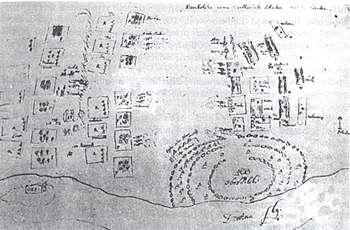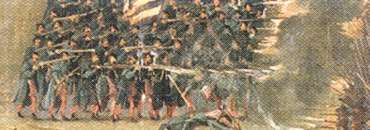
Battles and Campaigns
|
|
Swedish Polish War 1600 to 1609 Military Operations, 1607-1609 In 1607 most of the Polish-Lithuanian forces in Livonia had returned to Poland to help deal with internal rebellion. This gave Charles IX the opportunity to capture Bialy Kamien and the following year he took Dynemunt (27th July), Kokenhausen (8th August) and Felin (20th August). In the autumn Chodkiewicz returned and recaptured Kokenhausen and Felin, while in March 1609 the Hetman attempted a surprise attack on Dynemunt.
Soon however Chodkiewicz received news of the approach of Swedish reinforcements from Rewel, they were approximately 50km away and the hetman felt he must act now before they arrived. At 1:00 am on 16th March he ordered the attack. The small number of infantry he possessed meant he would need to coax his disgruntled nobles to fight dismounted. It needed all of Chodkiewicz's skills of persuasion and pleading to convince the nobles which he finally succeeded by taking his sabre in hand and walking towards the walls of the fort. His men rushed in aid of their commander in the storming of the castle - at least 7 banners took part, while a few banners remained protecting the horses. Parnawa town was most accessible to the Poles and Lithuanians from the South as it was surrounded on the North and West by the river. It had principally bastion fortifications as well as a powerful artillery of over 100 cannon. Two French engineers directed the operations to take the South gate, which was to be destroyed by a petard carried by some 14 Scottish infantry. Despite intensive defensive fire which inflicted some 20 casualties on the attackers the bomb reached the gate and it was destroyed. Soon the Commonwealth forces reached the castle and organised attacking fire at which point the Swedes surrendered. The attack had lasted less than 3 hours, killing 100 Swedes and wounding another 50, while the Poles/Lithuanians lost 50 with a similar number wounded.
Approaching the river Dwina Chodkiewicz felt too weak to attempt to tackle Mansfeld's whole army. To gain some advantage he spread word that reinforcements were coming from Courland and he crossed to the left side of the Dwina, towards his imaginary reinforcements. Mansfeld decided to destroy him before they could meet. He built a bridge over the Dwina and with only part of his forces across he ordered them in pursuit of Chodkiewicz. The waiting Chodkiewicz destroyed this initial Swedish force and followed up by crossing the bridge and attacking the Swedes on the right bank. They had already begun withdrawing and their retreat disintegrated. Riga was relieved and with a few hundred men the Hetman blockaded Dynemunt. Around the middle of July Mansfeld, with around 6,000 men, besiged Parnawa basing his camp south of the town between the sea. He surrounded the town, placing fieldworks and block houses to defend against any relief force, as well as encircle the garrison. Chodkiewicz waited for reinforcements which arrived on 20th August, he collected almost 3,000 men and leaving a few hundred at Dynemunt he moved with the rest for Parnawa. By the begining of September he reached forests some 30km from Parnawa. The Swedes attempted to destroy his force with a sudden night attack, though they managed a surprise attack and forced their way into the Polish-Lithuanian camp they were ejected and pushed back. The Swedes provided a strong defence, closing tracks with felled trees with the crowns facing the enemy. Chodkiewicz made little headway against these obstacles so he avoided them travelling some 40km to approach from an unexpected direction.
Chodkiewicz, failing to coax the Swedes to battle, and with disgruntled forces decided on retreat. He strengthened his garrison in Parnawa with 1,000 men and provisions and on 22nd September moved south. Mansfeld followed the Poles and Lithuanians with some 3,000 French cavalry and 2,000 Swedish infantry, as well as an unknown number of Dutch and Scots. On 29th September Commonwealth forces entered the camp at Dynemunt. In November Mansfeld approached and attempted to secretly resupply the Dynemunt garrison. At first Chodkiewicz was able to observe the Swedes sufficiently to cut off their route to the fort in time. But on 6th November Mansfeld's evaded Chodkiewicz and moved directly to the Hetman's camp. The camp was situated near some heights and in the camp were only a few hundred rajtars and Cossacks. Mansfeld with 2,000 men sent part of his forces to eject the the forces in the camp leaving the remainder on the high ground. On news of this the Hetman sent to the camp two regiments (T. Dabrowa & Aleksander Holowczynski), these after combined with the defeated units and then struck the Swedes positioned in front of the camp and decisively defeating them. Swedish reinforcements moving from Dynemunt were met by Polish-Lithuanian forces near the Dzwina and crushed against the river in where many Swedes drowned. 12 standards and all the canon were taken. Mansfeld decided not to leave his advantageous position on the heights, possibly remembering Kircholm and slowly began to withdraw. Chodkiewicz sent forces in pursuit and succeeded in capturing canons and two standards. This pursuit triggered the collapse of the Swedish forces and the Dynemunt garrison, which was close to starvation, surrendered on 9th November. At the same time the Polish-Lithuanian cavalry confederated and went home. Activity in Muscovy distracted both the Swedes and the Commonwealth away from Livonia and activities here subsided. On 28th February 1609 the Swedes and Muscovites agreed on an alliance. A formal peace was signed between the Commonwealth and Swedes in 1611 extended till 1616. In 1617 the Swedes recommenced the war with the help of the traitor Walter Farensbach, capturing Parnawa, Windawa (in Courland) and Dynemunt. The latter two were returned in the agreement of 1618 which lasted 2 years. |
|
![]()
 Undeterred
by this failure he moved for Parnawa to repeat the same tactic.
On reaching Salis he turned away from the main road moving through
the forests and marshes in order to avoid being spotted. The freezing
temperatures made travel easier, though drifts of deep snow were
a problem, but by 14th March the Polish-Lithuanian forces halted
some 14km from Parnawa. Word had reached Parnawa of Chodkiewicz's
intentions and as a warning to the locals cannons were fired. Unfortunately
the Commonwealth forces thought that they had been discovered and
so rather than attacking they retreated to a more secure position.
The hetman struggled to control his forces, who bitterly complained
of their poor conditions and lack of provisions after the recent
arduous forced march. The Swedes meantime learnt of the presence
of the enemy forces but believed it was only a scouting party and
not the main Polish-Lithuanian army.
Undeterred
by this failure he moved for Parnawa to repeat the same tactic.
On reaching Salis he turned away from the main road moving through
the forests and marshes in order to avoid being spotted. The freezing
temperatures made travel easier, though drifts of deep snow were
a problem, but by 14th March the Polish-Lithuanian forces halted
some 14km from Parnawa. Word had reached Parnawa of Chodkiewicz's
intentions and as a warning to the locals cannons were fired. Unfortunately
the Commonwealth forces thought that they had been discovered and
so rather than attacking they retreated to a more secure position.
The hetman struggled to control his forces, who bitterly complained
of their poor conditions and lack of provisions after the recent
arduous forced march. The Swedes meantime learnt of the presence
of the enemy forces but believed it was only a scouting party and
not the main Polish-Lithuanian army.  Meanwhile
Mansfeld had landed, with some 8,000 men, at Riga and began besieging
the Port. While on route south Chodkiewicz learnt that part of the
Swedish fleet stood in Salis Port, blockading the coast of Livonia.
With two captured Swedish ships, a few English and Dutch merchant
vessels he acquired and armed and a few large sea boats Chodkiewicz
attacked the fleet in the night of 24th/25th March. They were completely
taken by surprise and the Poles/Lithuanians burnt two ships with
minimal losses scattering the remainder.
Meanwhile
Mansfeld had landed, with some 8,000 men, at Riga and began besieging
the Port. While on route south Chodkiewicz learnt that part of the
Swedish fleet stood in Salis Port, blockading the coast of Livonia.
With two captured Swedish ships, a few English and Dutch merchant
vessels he acquired and armed and a few large sea boats Chodkiewicz
attacked the fleet in the night of 24th/25th March. They were completely
taken by surprise and the Poles/Lithuanians burnt two ships with
minimal losses scattering the remainder.  Due
to the closed coastal route and the road from to Krakus Hetman almost
certainly moved East and then North East so as from the region of
Felin he could move West through the marshy terrain. Chodkiewicz
reached Parnawa at midnight on 15th September.First d
Due
to the closed coastal route and the road from to Krakus Hetman almost
certainly moved East and then North East so as from the region of
Felin he could move West through the marshy terrain. Chodkiewicz
reached Parnawa at midnight on 15th September.First d